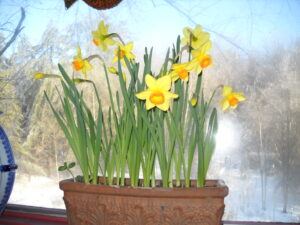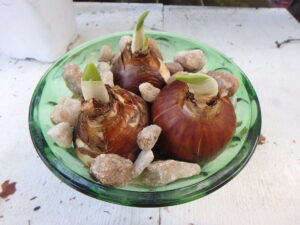Tips for Forcing Spring Bulbs to Bloom Indoors
Posted on Wednesday, November 4, 2020 · Leave a Comment
November is the gloomiest month of all. It’s cold and raw, but usually without enough snow to XC-ski on. It rains nearly every day, or seems like it does. The garden is put to bed, or if I‘ve neglected to do something, it probably won’t happen until spring. But this is a good time to force bulbs for early spring blooming indoors.
To force bulbs means preparing them in such a way as to force them to bloom early indoors, before they would bloom outdoors. Daffodils or crocus, for example, can be made to bloom by mid-February indoors, and tulips in March.

Daffodil bulbs ready to be covered with soil
On a raw day recently I planted 20 “Tete-a-Tete” daffodils in pots. Each of these will produce one or more brilliant yellow blossoms just when I’m sick of winter, and re-new my faith that spring is on the way. Bulbs have everything they need in order to bloom. All we have to do is offer a suitable place to spend the winter. Here is what I did:
First, I selected nice deep pots for planting. In the soil outside, daffodils are planted with six inches of soil over their pointy little noses. But in a pot, three inches is fine. I selected pots that were five or six inches deep, and placed 3 inches of potting soil in each. It’s fine to place the bulbs close together, just a couple of inches apart.
The potting soil I used was already damp, but after the bulbs were covered and ready for their winter sleep, I watered lightly. I will check them from time to time throughout the winter to make sure the soil does not dry out. The bulbs need moisture to develop roots and prepare to bloom. But be moderate: a soil mix that is soggy can rot roots.
I have a cold basement that I keep lightly heated to avoid freezing temperatures – my old house is set on a hill, and the basement is above ground in the back of the house where I keep my bulbs. The ideal temperature for forcing bulbs is around 40 degrees for good root development. You can begin the process by leaving your pots outdoors until real cold weather is upon us. Cover the pots with leaves to minimize temperature fluctuations.
If you have a warm basement, you can try placing pots in an unheated garage or mudroom, or perhaps in the bulkhead if you have one. Everything I have read says to keep the pots in a dark place, though I think that only matters once the bulbs have started to send up leaves or buds. The bulbs can’t know about light while covered with soil. So put the pots in a cardboard box if you have them in a garage with windows.
How long do bulbs need to stay dormant? The little bulbs – crocus, snowdrops and such – only need 8 to 10 weeks, daffodils need 12 weeks, and tulips need 16 weeks. I always place a plant tag in the pot with the date I started the process. And tulips will not bloom if you bring them into the warmth of the house before March.
Beware of mice and squirrels! Most old houses harbor at least a few mice. Once the mice go into my pots and ate all the tulip bulbs! Daffodils are mildly poisonous, so rodents will not bother them, and I’ve never had trouble with mice eating any alliums, which are good for forcing, too. I’ve had mice dig up bulbs, only to find they were daffodils and leave them on top of the pots, those rascals.
One way to know if your bulbs are ready is to look for roots poking out through the drainage holes of the pots. If you have daffodils that you planted 12 weeks ago but have not sent out any roots, they may be ready, but it would be safer to wait another week or two.

Forced daffodils blooming in early March
Once you bring your bulbs up into the house it will take two to four weeks more for them to bloom. Place the pot on a south or east windowsill and check daily. Water if the soil surface feels dry.
Will the bulbs bloom again next year? Tulips probably will not ever bloom again for you, even if you plant them outdoors in the spring. Daffodils can bloom again, but might take a couple of years to rebuild their energy enough to bloom.
Paperwhites are bulbs that can be forced without soil and an extended dormant cold period. These beauties are in the daffodil family and are sold for forcing in a bowl of gravel and water on a sunny windowsill. Most have a very strong fragrance, though not everyone likes it.
Select a deep bowl without a drainage hole. Place a one-to two-inch layer of gravel or small stones in the bottom, then place your paperwhites on it, shoulder to shoulder. Add water to the bowl until it just kisses the bottom of the bulbs. You don’t want water so deep the bulbs are wet, it is just for the roots that will grow.

Paperwhites are easy to force in pebbles and water
Next add more stones or gravel up around the bulbs. This will help to keep your flower stems from tipping over. Another way you can do is to keep stems short by giving them some gin! Start them in water, and after a week drain the water, and add a mixture of five parts water to one part gin. That will stunt the growth. Paperwhites started by the third week of November should bloom by Christmas. They will never bloom again, so put them in the compost after blooming.
We all need flowers. Starting some now is a great way to do it economically, so get going!
Henry can be reached by email at
henry.homeyer@comcast.net or at P.O. Box 364, Cornish Flat, NH 03746. He is the author or 4
gardening books.





